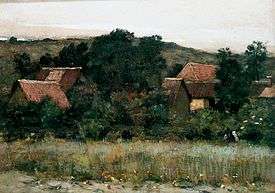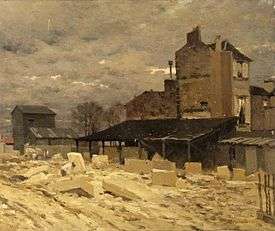Marie Cazin
Marie Cazin, née Marie Clarisse Marguerite Guillet (19 September 1844, Paimbœuf – 18 March 1924, Équihen-Plage)[1] was a French landscape painter, decorative artist and sculptor.
Marie Cazin | |
|---|---|
| Born | Marie Clarisse Marguerite Guillet September 19, 1844 Paimboeuf, France |
| Died | March 18, 1924 (aged 79) Equihen, France |
| Nationality | French |
| Known for | Painting, Sculpture |
| Movement | Impressionism |
| Spouse(s) | |


Biography
She studied in Paris with Juliette Peyrol-Bonheur (1830–1891), the sister of Rosa Bonheur, and with Jean-Charles Cazin, whom she married in 1868. Beginning in 1876, she exhibited paintings at the Salon des Artistes Français and, from 1882, presented sculptures as well.[2] She also exhibited at the Royal Academy of Arts in 1874 and 1878.
Her best-known sculpture, "The Young Ladies" was shown in 1886 and purchased by the government in 1899. It is now on display at the Musée du Luxembourg. She exhibited with Les XX in Brussels in 1887 and won a gold medal at the Exposition Universelle (1889).
In 1891, she became a member of the Société Nationale des Beaux-Arts.[3] Cazin exhibited her work at the Palace of Fine Arts at the 1893 World's Columbian Exposition in Chicago, Illinois.[4] Following her husband's death, she designed the monument for his tomb. She also designed a monument to doctors Hubert Cazin (1724-1795)[5] and Paul Perrochaud in Berck.
A prominent theme in her paintings are women at work. During the First World War, she maintained a studio in the Latin Quarter. In addition to her regular work, she created several frescoes on commission and did designs for the Gobelins Manufactory. A few years before her death, she retired to Pas-de-Calais.
Her son, Michel Cazin (1869–1917), became a well-known engraver.
Cazin was included in the 2018 exhibit Women in Paris 1850-1900.[6]
References
- "Marie Cazin 1844–1924". The Tate. Retrieved 6 August 2017.
- "Marie Cazin". National Gallery, London. Retrieved 30 December 2014.
- Gaze, Delia (1997). Dictionary of Women Artists: Artists, J-Z. Taylor & Francis. ISBN 9781884964213.
- Nichols, K. L. "Women's Art at the World's Columbian Fair & Exposition, Chicago 1893". Retrieved 24 July 2018.
- Pas-de-Calais, Commission départementale des monuments historiques du (1886). Épigraphie du département de Pas-de-Calais (in French).
- Madeline, Laurence (2017). Women artists in Paris, 1850-1900. Yale University Press. ISBN 978-0300223934.
External links
| Wikimedia Commons has media related to Marie Cazin. |
- Biography and two sculptures @ the Nella Buscot website
- Shakuntala, sculpture, @ Les Yeux Dans La Hune blog